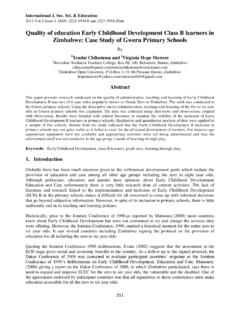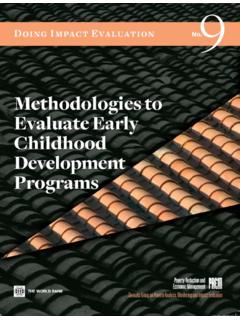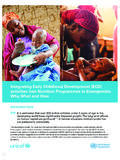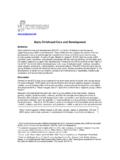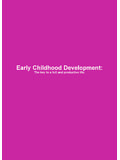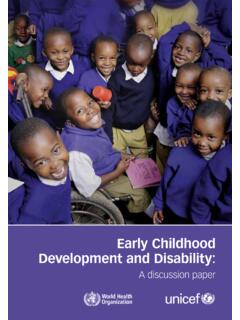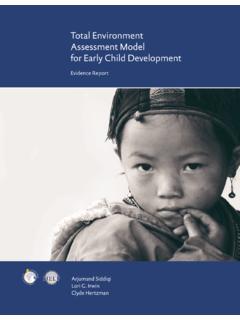Transcription of Early Childhood Development in Emergencies - …
1 Early Childhood Development in Emergencies : Integrated Program Guide | AEarly Childhood Development in Emergencies Integrated Programme Guide@UNICEF/RWANDA/2014/SCHIERMEYER UNICEF/INDA2010-00606/PIROZZI@UNICEF/RWA NDA/2014/SCHIERMEYER UNICEF/NIGB2010-0048/PIROZZIACKNOWLEDGEM ENTSThis guide is based on the draft paper Integrated Quality Framework for Early Childhood Development in Emergen-cies produced by Vidur Choprah. Technical inputs and revisions were provided by Dr. Cassie Landers. The guide was further reviewed and revised by Nurper Ulkuer, Pia Britto, Vijaya Singh, Aster Haregot, Eva Lotta-Schiermeyer and Arnaud Conchon.
2 Thanks to all UNICEF Regional Offices and HQ Programme Sections for their input and feedback, to Anna Zonderman for editorial assistance and Kerstin Vogdes Diehn for the design and Childhood Development in Emergencies : Integrated Program Guide | 1 TABLE OF CONTENTSINTRODUCTION ..2 SECTION I ECD: BASIC CONCEPTS AND PROGRAMME PRINCIPLES ..3 ECD Programme Principles ..6 SECTION II SECTOR ENTRY POINTS FOR QUALITY ECD PROGRAMMES ..8 Suggested ECD Interventions During Emergency Phases ..10 Preparedness ..10 Response ..12 Early and Evaluating ECD in Emergencies ..14 ECD Inter-Agency Task Force ..15 SECTION III INTEGRATING ECD WITHIN SECTORS.
3 16 ECD through Health Interventions in Emergencies ..17 Integration of Nutrition Programmes and ECD in Emergencies ..20 ECD through Education Programmes in through Water, Sanitation and Hygiene (WASH) in Emergencies ..28 Integration of Child Protection Interventions with ECD in Emergencies ..30 Integration of HIV and AIDS with ECD in Emergencies ..33 SUMMARY ..36 ANNEX I Sample Indicators for ECD in Emergencies ..38 ANNEX II Early Childhood Needs Assessment: Suggested Guidelines ..42 ANNEX III ECD Task Force: Suggested Terms of Reference ..43 ANNEX IV Suggested Code of Conduct: Early Childhood Care Facilitators.
4 44 2 | Early Childhood Development in Emergencies : Integrated Program GuideOVERVIEW Emergency settings pose a multitude of risks to young children and their families, and can have adverse effects on young children s Development . Worldwide, over 1 billion children live in areas affected by conflict and high levels of violence,1 with an additional 175 million children likely to be affected by climate-related disasters each an increasing recognition of the importance of Early Childhood Development (ECD) in recent years, a critical gap in humanitarian responses has been observed with regard to mitigating the negative consequences of emergency settings on young children s overall devel-opment.
5 In 2011, an average of 13 per cent of refugees, asylum seekers and internally displaced persons were children under the age of Children in such fragile and conflict-affected settings are twice as likely to die before they reach their fifth With this in mind, it is critical that children s rights to life, survival and de-velopment including, specifically, the rights to health, nutrition, education, rest, leisure and engagement in play (as enshrined in the United Nations Convention on the Rights of the Child) are continuously protected, promot-ed and upheld. RATIONALE One of the most sensitive phases in human Development occurs from the prenatal period through age 8 years.
6 This 1 UNICEF. (2012). Early Childhood Development kit: A treasure box of activities. Available on the UNICEF intranet (password required): UNICEF. (2010). UNICEF humanitarian action: Partnering for children in Emergencies . New York, NY: UNHCR. (2011). Global trends 2011: A year of crisis. New York, NY: World Bank. (2011). World Development Report 2011. Washington, DC: World is characterized by rapid brain Development and the acquisition of foundational skills and competencies. The architecture of the developing brain forms progressively, such that the quality of Early experiences establishes ei-ther a sturdy or a fragile foundation for the brain s further Research shows that investing in Early Childhood interventions accrues long-term economic and social returns to both regular and emergency settings, quality Early Childhood foundations can help ensure a smooth transi-tion to primary school, a better chance of completing basic education, and a route out of poverty and Through positive influences on learning achievement, skills acquisition.
7 And health outcomes, ECD interven-tions provide a pathway to the eradication of extreme poverty a primary goal of the Millenium Development Goals. It is also widely acknowledged that investing in Early Childhood interventions is more effective and less costly than investing in remedial interventions at later points in interventions are cross-sectoral in nature, and their effective implementation relies on their integration into programmes across multiple sectors, including health, nutrition, education and child protection. An integrated approach to programming such as this, relies on effective 5 National Scientific Council on the Developing Child.
8 (2007). The science of Early Childhood Development : Closing the gap between what we know and what we do. Boston, MA: Heckman, J. J. (2006). Skill formation and the economics of invest-ing in disadvantaged children. Science, 312, 1900 UNESCO. (2007). Education for all Strong foundations: Early child-hood care and education. Paris, France: Heckman, J. J. (2006). Skill formation and the economics of invest-ing in disadvantaged children. Science, 312, 1900 1902; National Scientific Council on the Developing Child. (2007). The science of Early Childhood Development : Closing the gap between what we know and what we do.
9 Boston, MA: NSCDC. INTRODUCTIONE arly Childhood Development in Emergencies : Integrated Program Guide | 3coordination between ECD and other sectors. In emer-gency contexts, it is particularly challenging to ensure the needs of the youngest children are met in a holistic manner. A well-coordinated integrated programming ap-proach relies on buy-in from senior management, a ded-icated human resource capacity for ECD, and advocatcy for the prioritization of a holistic approach to addressing young children s needs across sectoral emergency re-sponses. This programme guide provides an overview of entry points for ECD programming in are situations that threaten the lives and wellbeing of a large portion of a population, and that require extraordinary action to ensure care, protection and survival, as every basic living standard, condition and context is A situation is referred to as an emergency when the national authority of the state calls for external assistance in dealing with the situation and officially declares it as an emergency.
10 This programme guide follows the time frame adopted in UNICEF s Core Commitments for Children in Humanitarian Action, goal of the integrated programme guide for ECD in Emergencies is to guide the humanitarian community in designing a response that takes into account the needs of young children. The objectives of the guide are: To provide guidelines for supporting and enabling young children s Development in all phases of emer-gencies; To advocate for prioritizing ECD on the humanitarian preparedness, response and Early recovery agenda and for ensuring that all of its components are ade-quately addressed; To facilitate the integration of ECD into individual sectoral responses and the coordination of a com-prehensive response among the health; nutrition; water, sanitation and hygiene (WASH); education; child protection; HIV and AIDS.










